
Wet harvesting vs dry harvesting Illustration
Wet harvesting involves collecting crops when they contain higher moisture levels, facilitating easier handling but requiring immediate processing to prevent spoilage. Dry harvesting waits until crops reach lower moisture content, reducing storage risks and enhancing grain quality but demanding more energy for threshing and cleaning. Choosing between wet and dry harvesting depends on crop type, weather conditions, and storage capabilities.
Table of Comparison
| Harvesting Method | Wet Harvesting | Dry Harvesting |
|---|---|---|
| Definition | Collecting crops with moisture content intact | Collecting crops after natural drying |
| Moisture Level | High (above 20%) | Low (below 15%) |
| Harvest Time | Immediately after maturity | Delayed until crops are dry |
| Equipment Needed | Wet processing machinery | Standard harvesting tools |
| Post-Harvest Processing | Requires drying or wet processing | Minimal additional processing |
| Advantages | Reduces spoilage, suitable for water-intensive crops | Lower energy use, easier storage |
| Disadvantages | Higher processing costs, risk of mold | Longer field exposure, possible losses |
Understanding Wet Harvesting and Dry Harvesting Methods
Wet harvesting involves collecting crops with high moisture content, typically from fruits like grapes or coffee cherries, to preserve freshness and reduce damage during transport. Dry harvesting, on the other hand, is done when crops have lower moisture levels, ensuring longer storage life and minimizing spoilage risks, commonly used for grains and nuts. Choosing between wet and dry harvesting depends on the crop type, climate conditions, and intended use to maximize quality and yield.
Key Differences Between Wet and Dry Harvesting Techniques
Wet harvesting involves collecting crops while they are still moist, reducing dust and often preserving freshness, which is ideal for delicate produce like grapes and rice. Dry harvesting gathers crops after they have fully dried on the plant, enhancing storage life and minimizing mold risk, commonly used for grains and beans. The choice between wet and dry harvesting impacts post-harvest processing efficiency, product quality, and storage requirements.
Pros and Cons of Wet Harvesting in the Garden
Wet harvesting in the garden involves collecting crops while they are still moist, which helps reduce mechanical damage and prevents plants like grapes from shriveling. This method minimizes field losses and maintains crop quality, especially for fruits with delicate skins. However, wet harvesting can increase the risk of mold and fungal growth during storage and transportation, requiring immediate cooling and careful handling to preserve freshness.
Advantages and Disadvantages of Dry Harvesting
Dry harvesting minimizes crop moisture content at collection, reducing the risk of mold and spoilage during storage. It requires more energy and labor for post-harvest processing, potentially increasing operational costs compared to wet harvesting. The process is also more susceptible to losses from shattering and mechanical damage in certain crops, impacting overall yield quality.
Impact of Harvesting Methods on Crop Quality
Wet harvesting enhances crop freshness by minimizing mechanical damage and preserving moisture content, which is particularly beneficial for delicate fruits like grapes and rice. Dry harvesting, while reducing fungal growth and post-harvest diseases due to lower moisture levels, may increase physical bruising and nutrient loss in crops such as wheat and corn. The choice between wet and dry harvesting significantly influences the shelf life, market value, and overall quality of agricultural produce.
Choosing the Right Harvesting Technique for Your Garden
Choosing between wet harvesting and dry harvesting depends on the type of crop and environmental conditions. Wet harvesting, which involves harvesting crops with high moisture content, is ideal for crops like rice and fruits to minimize damage and preserve freshness. Dry harvesting suits grains and seeds, as it allows for easier threshing and storage without the risk of mold or spoilage.
Step-by-Step Guide: Wet Harvesting Process
Wet harvesting involves immersing crops in water to facilitate easier separation and minimize damage during collection. The process begins with submerging the plants in a water tank, followed by gentle agitation to detach fruits or leaves. The final step includes draining and sorting the harvested products for quality and further processing.
Step-by-Step Guide: Dry Harvesting Process
Dry harvesting involves cutting crops at optimal maturity when moisture content is low, preventing mold and spoilage during storage. Begin by cutting plants close to the ground using a sickle or mechanical harvester, then bundle and cure them in a well-ventilated area to reduce residual moisture. Once dried, thresh the bundles carefully to separate grains or fruits without damaging the produce, followed by cleaning and storing in moisture-controlled environments to maintain quality.
Best Crops for Wet Versus Dry Harvesting
Wet harvesting is ideal for crops like rice and sugarcane, where high moisture content facilitates easier processing and reduces grain damage. Dry harvesting suits grains such as wheat, barley, and maize, where low moisture prevents spoilage during storage. Selecting the appropriate method based on crop type optimizes yield quality and post-harvest handling efficiency.
Common Mistakes to Avoid When Harvesting Wet or Dry
Common mistakes when wet harvesting include failing to avoid excess moisture, which can lead to mold and spoilage, and improper timing that reduces crop quality. In dry harvesting, neglecting to control humidity and temperature often causes product degradation and loss during storage. Ensuring proper handling techniques tailored to the specific moisture conditions prevents contamination and preserves yield quality.
Wet harvesting vs dry harvesting Infographic

 gardendif.com
gardendif.com